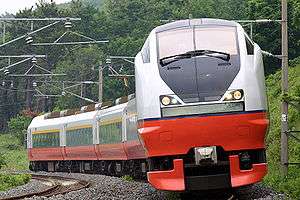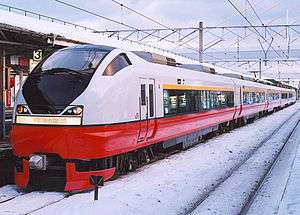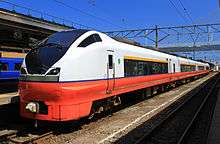E751 series
The E751 series (E751系) is an AC electric multiple unit (EMU) train type operated on Tsugaru limited express services in the north of Japan by East Japan Railway Company (JR East) since March 2000. The design was based on the earlier (1,500 V DC) E653 series EMUs, with improvements to cope with colder weather conditions in the north of Japan.[1]
| E751 series | |
|---|---|
 An E751 series 6-car set on a Tsugaru service in June 2006 | |
| In service | March 2000–Present |
| Manufacturer | Tokyu Car Corporation |
| Built at | Yokohama |
| Replaced | 485 series |
| Constructed | 1999–2000 |
| Number built | 18 vehicles (3 sets) |
| Number in service | 12 vehicles (3 sets) |
| Number scrapped | 6 vehicles |
| Formation | 4 cars per trainset |
| Fleet numbers | A101–A103 |
| Operator(s) | JR East |
| Depot(s) | Aomori |
| Line(s) served | Ōu Main Line |
| Specifications | |
| Car body construction | Aluminium alloy |
| Car length |
|
| Width | 2,976 mm (9 ft 9.2 in) |
| Floor height | 1,140 mm (3 ft 9 in) |
| Doors | 1 per side |
| Maximum speed | 130 km/h (80 mph) |
| Traction system | MT72 145 kW (194 hp) x 4 per motor car 3.48 MW (4,670 hp) per unit |
| Electric system(s) | 20 kV AC (50 Hz) |
| Current collection method | Overhead line |
| Bogies | DT64A (motored), TR249A (trailer) |
| Safety system(s) | ATS-Ps |
| Track gauge | 1,067 mm (3 ft 6 in) |
Formations
4-car sets (April 2011–Present)
The original six-car sets were shortened to four cars as shown below from 23 April 2011.[2] The sets were occasionally lengthened to six cars for increased capacity during busy periods by inserting a pair of MoHa E751 and MoHa E750 cars[3] until the three pairs of MoHa E751 and MoHa E750 cars were withdrawn in 2015.[4]
| Car No. | 1 | 2 | 3 | 4 |
|---|---|---|---|---|
| Designation | Thsc | M1 | M2 | Tc |
| Numbering | KuRoHa E750 | MoHa E751-100 | MoHa E750-100 | KuHa E751 |
| Weight (t) | 30.7 | 34.8 | 33.1 | 29.0 |
| Capacity | 38 (16 Grn + 22 Std) | 72 | 72 | 68 |
Car 2 is equipped with one PS107 single-arm pantograph.
6-car sets (March 2000–April 2011)
Sets were originally formed as six-car sets, consisting of four motored cars and two trailers, as shown below.[1][5] Sets were shortened to four cars from 23 April 2011.[6]
| Car No. | 1 | 2 | 3 | 4 | 5 | 6 |
|---|---|---|---|---|---|---|
| Designation | Tc1 | M2 | M1 | M2 | M1 | Tsc' |
| Numbering | KuHa E751 | MoHa E750-100 | MoHa E751-100 | MoHa E750 | MoHa E751 | KuRoHa E750 |
| Weight (t) | 29.0 | 33.1 | 34.8 | 33.1 | 34.8 | 30.7 |
| Capacity | 68 | 72 | 72 | 72 | 72 | 38 (16 Grn + 22 Std) |
Cars 3 and 5 are each equipped with one PS107 single-arm pantograph.
 KuHa E751
KuHa E751 MoHa E750-100
MoHa E750-100 MoHa E751-100
MoHa E751-100 MoHa E750
MoHa E750 MoHa E751
MoHa E751 KuRoHa E750
KuRoHa E750
Interior
Seating is configured 2+2 abreast in both standard class and Green class. Seat pitch is 910 mm (36 in) in standard class and 1,160 mm (46 in) in Green class.[1][6]
 Standard-class accommodation (MoHa E750-100)
Standard-class accommodation (MoHa E750-100) Green-class accommodation (KuRoHa E750)
Green-class accommodation (KuRoHa E750)
History

The first set was delivered to Aomori Depot from Tokyu Car Corporation's Yokohama factory on 9 December 1999, followed by the remaining two sets in January 2000. The fleet entered service on Super Hatsukari services operating between Morioka and Aomori from the start of the revised timetable on 11 March 2000.[5]
From 1 December 2002, the E751 series trains were reassigned to new Tsugaru services operating between Hachinohe and Hirosaki, which replaced the former Super Hatsukari services following the opening of the Tōhoku Shinkansen extension from Morioka to Hachinohe.[7]

In late 2006, all three sets underwent modifications at JR East's Kōriyama Works to reinforce the front end snowploughs and add protection plates to underfloor equipment.[5]
From the start of 4 December 2010 timetable revision, the E751 series sets were replaced on Tsugaru services by 4-car 485-3000 series EMUs,[8] and were temporarily removed from regular service. From 23 April 2011, the fleet of three E751 series sets were reinstated on Tsugaru services, this time formed as 4-car sets, replacing the 485-3000 series sets.[6] The three pairs of MoHa E751 and MoHa E750 cars removed were stored at Aomori Depot, and occasionally reinserted into sets to provide increased capacity during busy seasons[3] until the three pairs of cars were withdrawn in 2015.[4]
Build details
The build details for the three sets are as follows.[5]
| Set No. | Manufacturer | Date delivered |
|---|---|---|
| A101 | Tokyu Car | 9 December 1999 |
| A102 | Tokyu Car | 12 January 2000 |
| A103 | Tokyu Car | 27 January 2000 |
Further reading
- E751系特急形交流電車 [E751 series limited express AC EMU]. Japan Railfan Magazine (in Japanese). Vol. 40 no. 467. Japan: Koyusha Co., Ltd. March 2000. pp. 18–24.
References
- JR全車輌ハンドブック2009 [JR Rolling Stock Handbook 2009]. Japan: Neko Publishing. 2009. ISBN 978-4-7770-0836-0.
- JR電車編成表 2011夏 [JR EMU Formations - Summer 2011]. Japan: JRR. May 2010. p. 16. ISBN 978-4-330-21211-1.
- Matsumoto, Norihisa (April 2014). 転用進むJR特急車 [JR Limited Express Trains and Continuing Reassignment]. Japan Railfan Magazine (in Japanese). Vol. 54 no. 636. Japan: Koyusha Co., Ltd. pp. 28–29.
- 車両のうごき2015-2016 [Rolling Stock changes 2015-2016]. Japan Railfan Magazine (in Japanese). Vol. 56 no. 663. Japan: Koyusha Co., Ltd. July 2016. p. 66.
- JR電車編成表 2010夏 [JR EMU Formations - Summer 2010]. Japan: JRR. May 2010. p. 14. ISBN 978-4-330-14310-1.
- 特急「つがる」へのE751系車両導入について [Introduction of E751 series trains on "Tsugaru" limited express] (PDF) (in Japanese). Japan: East Japan Railway Company - Akita Branch. 19 April 2011. Retrieved 24 April 2011.
- Haraguchi, Takayuki (2009). Encyclopedia of JR's Railway Cars: JR全車輌. Japan: Sekai Bunka. p. 50. ISBN 978-4-418-09905-4.
- 2010年12月ダイヤ改正について [December 2010 Timetable Revision] (in Japanese). JR East - Akita Branch. 24 September 2010. pp. 8–9. Archived from the original (pdf) on 10 October 2010. Retrieved 6 December 2010.
External links
| Wikimedia Commons has media related to E751 series. |
- JR East E751 series description (in Japanese)